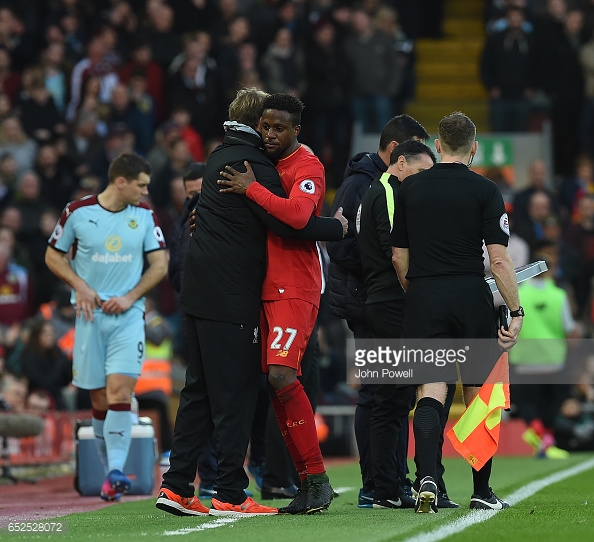Divock Origi has struggled to make an impact for Liverpool since Christmas; limited to just a handful of starts in the FA Cup and given very little opportunity to prove himself in the Premier League.
However, he was given a start in Sunday’s 2-1 win against Burnley at Anfield in the absence of first choice centre-forward Roberto Firmino. So how did Origi perform?
Struggled with Liverpool’s tactics
Overall, it’s hard to gauge exactly how well Origi played. It’s impossible to rate his performance fairly without taking into account the tactics that Liverpool employed, and the service that Origi was given. And sadly, on both counts the answer does not favour the Reds. Liverpool’s tactical game was very poor and one-dimensional, as they played a lot of long balls up to Origi.
Whilst Origi is a very physical player, he doesn’t suit a long ball tactic, since winning aerial battles is not one of his strengths. Origi’s aerial threat primarily comes from his movement, but it’s not possible to do that when the ball is being thumped up to you, especially against a physical side like Burnley. As a result, this is one area of Origi’s game that it is easy to criticise, as he won just three of his 15 aerial duals, but it’s important to recognise that Liverpool shouldn’t have been trying that tactic all game when it clearly wasn’t working.

Another issue for Origi is his overall lack of influence. He touched the ball just 26 times in the 78 minutes he was on the field which is comfortably the least of anyone who started the match, with Philippe Coutinho, who played an hour, notching 48 touches. Moreover, he failed to notch a single shot, which is extremely worrying for a striker.
Again however, this is an issue that can be blamed on team tactics. Liverpool’s determination to play the ball long to Origi rather than along the floor meant that Origi rarely got the ball into his feet where he likes it, running into the channels and in behind Burnley’s defence.
There were few occasions where the balls into the box was good enough to create a chance for Origi, and indeed the only good ball into the box that led to a chance was made by Origi himself for Georginio Wijnaldum’s goal.
Effective when given the chance
What will be encouraging for Liverpool is that when Origi was given the chance to run into the channel, he caused Burnley problems. Whilst, as noted, Origi didn’t register a single shot, he did manage to register two assists, which is extremely promising, especially given that both goals came about through Origi drifting off to the left hand side of the box.
The first goal was an excellent cross from Origi into the feet of Wijnaldum, whose finish was emphatic. The Belgian also played his part in Liverpool’s second goal: the winner scored by Emre Can. Again he picked up the ball in the left channel and this time played a clever pass inside, freeing up Can to pull the trigger.
What’s important to note here is that if Liverpool can get Origi into the right areas then his link-up play is excellent. In a game in which Liverpool played very poorly and struggled to get the ball up to their main striker in an effective way, the positive signs were there that if they could get the ball into Origi’s feet more often in the final third then he would make things happen.
Overall, it’s difficult to read too much into Origi’s performance, given Liverpool’s overall stuttering display, and poor tactical game plan. However, Origi made a lot out of very little and there were clear signs that he can be very effective in this Liverpool team, given time to operate.






































